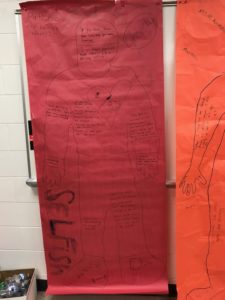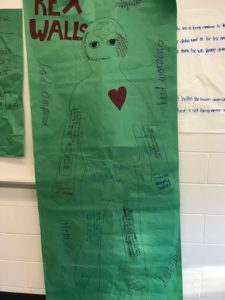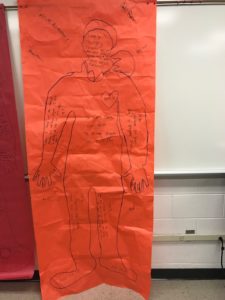The first time I experienced a body biography assignment, I was a student in an 11th grade British Literature class. That would have been almost 15 years ago. We were reading the prologue to The Canterbury Tales, and my teacher, Mr. O’Dowd, placed us into small groups to analyze the characters using body biographies on large sheets of paper. Then, we had to present our body biographies to the class.
The body biography assignment still stands out to me as one of my favorites as a student. I remember a lot of details about the characters from The Canterbury Tales, and I learned a lot about characterization. It was an assignment that was fun for me, but it also pushed me and my group to think critically about what we were putting on the paper.

What, Exactly, Is a Body Biography?
When I have my students do body biographies, I divide them into groups of 4 or 5. They trace one person’s outline onto a big piece of butcher block paper, and then they choose or are assigned a character from the text we’re reading. They have to record certain characteristics and information about that character on the butcher block paper. Sometimes, I make it more free form, like choose 5 quotes, 5 symbols, and 10 words that represent the character, and place those that are most important near the heart, and those that are less important further out in the body. This year, most of my students work best with more structure, so this is how I set it up. I also tried out a single-point rubric, and loved it, but that’s a topic for another post.

How Did It Go?
I have been using body biographies in my own classroom since I started teaching, and this year, as with most years, the days when my students were working on their body biographies were some of my favorites of the whole school year so far. We were about ⅔ of the way through The Glass Castle by Jeannette Walls when we started the assignment, and one of the assessment tasks I had set up at the beginning of the unit was to analyze how the characters developed and changed over the course of the novel, so body biographies gave my students a great chance to practice some skills they would need.
As students traced their outlines and thought about how the characters looked physically, they were laughing and joking about their work. They were also on task, looking through the book to try to figure out how their characters were described physically. They didn’t have to draw their faces or other physical features this time, but some wanted to, and they wanted to be accurate.
Some groups divided out tasks: “Alright, you look for 4 events that were important to the character, and I’ll try to figure out the adjectives.”
Some had to clarify some of the terms of the assignment first: “Wait, what’s a symbol? Didn’t we just learn that term? What’s an adjective again?’ They helped each other figure out what it all meant and checked in with me to make sure they were on the right track.
I walked around and listened in and observed. In most groups, I knew that one or two people hadn’t been keeping up with the reading, and they definitely struggled to contribute. I conferred with them as I walked around and asked what they could do for their groups even though they were behind. Some of them did some research to learn more about the character they were working on quickly. Others took on a different role in the group, such as transferring information from the planning handout to the poster. Still others prepared to take on a bigger role in the presentation by asking their other group members why they chose certain quotes, adjectives, or symbols.
There were some students who did not participate much with their groups even after I talked with them and tried to help them find ways to contribute. I take this as a sign that I need to do two things differently next semester. First, I need to emphasize small group norms and expectations more from the beginning of the semester and give them more practice with those. Second, I think I need to identify specific group roles for this assignment and have them choose those roles on the first day of working on it. That will help all group members know what they need to do to contribute to the whole group’s success.

The quality of the different groups’ presentations also varied greatly. Some just read what they wrote down with very little explanation of why they chose those quotes, symbols, and adjectives, even though I had heard them sharing their reasoning and analysis as they made their choices. Others explained each choice in great detail. I think next semester, I will present an example from the first book we read before students begin work on their body biographies so that they will have more of a model for how their presentations should go.
What did The Students Think Of It?
During and after the presentations, I had students complete this reflection assignment. I was most interested in what they would say in response to the four reflective questions on the back. Here are some of their responses:
- What do you think you learned from creating a body biography of one character from The Glass Castle?
- “I learned more about Rose Mary Walls…because I learned from other people who knew stuff about her that I didn’t catch.”
- “The thing I learned from creating a body biography is getting to know more about the characters, understanding more of what character is like.”
- “It helps understand the character inside and out. It tells us a lot about how she is feeling in her childhood and what she did to deal with that stress on her.”
- What did you learn from listening to others present their body biographies?
- “It’s interesting hearing other people’s perspectives on the characters.”
- “I found some symbols that I didn’t really think of.”
- How did you practice the skills listed in the learning goals for the project? Do you think it helped you improve those skills?
- “I can use evidence shown in the book to help describe or explain something about the character.”
- Do you think this was a good learning activity for you? Why or why not?
- “Yes, because I could tell based on people’s evidence how a character is.”
- Yes, “because we got to understand the characters.”
- “Yes, because I didn’t know much about Rose Mary.”
Most students said yes to number 4, but not everyone. The ones who said no mostly said that they work better alone, or that their groups were not helpful, or that they prefer more traditional writing assignments to visual representations and presentations. I get that, but I still think that, on the whole, body biographies are a great way for students to practice character analysis. Most of my students thought so, too, and they had fun in the process of creating them.